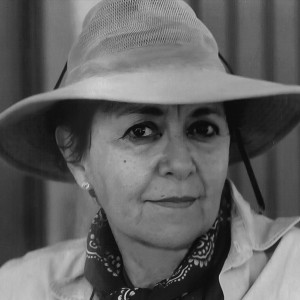This is a stone carved in bas-relief, located in Room 4 on the first floor of the Cuauhnahuac Regional Museum. We start reading from the upper right-hand corner, where we can see a place name consisting of a U-shaped band with a straight base and sides. This probably represents the cross section of a river, or a container (as the inside does not have the glyph for water). There is a bird inside it, which could be a parrot due to the shape of its beak. Taken together, this reads as “the place of parrot river” or “the parrot container”, although I prefer the former. There is a house below this place name, which is read as “the town.” The date “3 monkey” is inside the house. There are two parallel lines below both the house and the “3 monkey” glyph, which have human footprints between them indicating “the path." There is a man walking on the path who carries a woman on his back. Her body is inside a bundle and her head can be seen on top of it. Codices and sources give an extensive description of how the bride is moved when she is to be married: she is carried to the groom’s house. The “3 monkey” glyph is probably the bride’s name.
This path leads to a location consisting of a figure with three straight sides (side, base and top) and one tiered side. It has the head of a turkey inside it. This place name would be the place “where the caged turkeys are” or the place “where they catch turkeys with traps.” It was probably the name of the city of Xochicalco. Above the place name is “a man sitting on a stela.” In front of him is the date “2 movement,” which is the name of this person, the future husband of the woman “3 monkey.”
On the top of the man “2 movement” is the representation of a house, which means the same as before, the town where the caged turkeys are or the place where they catch turkeys with traps. We can see “a man carrying half a ballcourt with half a sun inside it” in the upper central section. We know that the ballgame meant the universe to the Mesoamericans, as the celestial objects were in constant motion, so this could be interpreted as “the bearer of the universe.” Next to him is the date “2 movement.” We consider this to be the person’s name.
In the center of the slab is a date we shall read from bottom to top: year “4 house,” day “10 vulture”: surely the date on which the woman “3 monkey” set off on her voyage to her fiancé’s house. The second date indicates a day “6 leg,” a year “4 rabbit” and the day “9 A glyph,” which possibly corresponds to the day 9 grass.
It is common to find a certain imprecision as to dates in pre-Hispanic manuscripts, as is the case here, where two different days are given in the same year. What we can therefore read is as follows:
In the year “4 rabbit,” between the days “6 leg” and “9 grass,” the woman “3 monkey” from Parrot River arrived at the Place where the Caged Turkeys are for the purposes of a matrimonial alliance between both towns.
If we begin reading in the middle, the account would be as follows:
In the year “4 house” on day “10 vulture,” the woman “3 monkey” left the town of Parrot River to marry the man “2 movement,” Bearer of the Universe, great dignitary of the Place where the caged Turkeys are or where they catch Turkeys in traps. They were joined in matrimony in the year 4 between days 6 and 9.
This is why these records are cataloged as half-writing, and not as true writing.
Identification Record
Name or topic: Stela
Inventory Number: 10-344139
Type of object: Architectural Element
Raw material: Andesite stone
Shape: Square and rectangular
Manufacture technique: Carved
Decorative technique: High relief
Decorative motifs: Symbolic
Culture: Central Mexican Plateau
Period: Classic (200-900 AD)
Place of origin: Xochicalco, Morelos
Acquisition: Cuauhnahuac Regional Museum Collection
Location: Room #4 First Floor
Condition: Good
Length: 20.9 inches.
Width: 7 inches.
Height: 20.1 inches.








